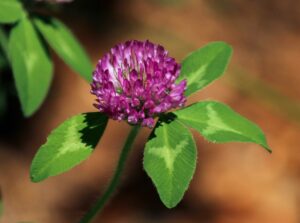Red clover is a legume commonly grown in Australian pastures and is particularly favoured for cattle pastures. Its ability to fix soil nitrogen levels and its high feeding value means that it can feed a hungry herd whilst also improving soil fertility for future crops.
Like with anything, red clover has its pros and cons. Let’s take a look at the benefits of planting red clover, as well as potential pitfalls.
Pros of Red Clover
The big drawcard for clovers is the nitrogen fixation. Even if you’re not using the plant for pasture it can be useful for increasing soil fertility for future crops or planting.
The way that clover varieties cover the ground and retain moisture means that weeds rarely get the opportunity to grow when clover is present. Because of this, orchardists and other growers of row trees often plant clover as a ground cover. It can happily withstand the foot traffic as people walk between the rows, and it keeps moisture in – it’s a very effective living mulch.
Red clover is reasonably drought resistant, but gives best results in temperate areas with an annual rainfall of about 700ml. In areas with dry summers the legume will grow best if it is irrigated over summer. Summer is its best growing season and it needs the rainfall or irrigation to grow to its full potential.
In a pasture, red clover can be a very useful addition. It will grow well with other temperate pasture grasses such as ryegrass, meaning you can plant a truly effective blended pasture. It is also quick to grow, lending itself nicely to short term pasture crops.
The feeding value of red clover is high, providing a good source of protein to livestock. Even better is that red clover is very palatable – your cows (or sheep, horses, and other livestock) will love chowing down on the red clover. The high quality is not lost when the plant is harvested for hay or silage. Hay and silage made from red clover are recommended for finishing lambs, cattle, and milking cows.
Cons of Red Clover
Whilst red clover is easy to grow in temperate areas with decent rainfall, it really struggles outside of these conditions. There’s not much leeway in the climate that it will grow well, so it’s really only a plant for southern Australia. The Northern Territory, Queensland, and Western Australia need not consider red clover.
Adequate rainfall is the biggest issue for most southern areas of Australia when it comes to growing red clover. The temperature may be right, the soil may be right, but if you don’t get that magic 700ml annually, your red clover most likely won’t deliver the goods.
Red clover prefers loamy soil. Areas with poor drainage or salinity problems will not produce good red clover crops.
Red clover’s weed resistance is counterbalanced by its propensity to fungal diseases. These diseases can easily be treated, but they are something that need to be considered and monitored.
The most oft-discussed drawbacks of red clover are the potential problems it can cause with fertility in livestock, and with bloating. If red clover is the predominant plant in the pasture it can cause bloating. This is easily avoided by planting red clover as part of a blend, usually with ryegrass. The other potential problem is caused by oestrogenic compounds which has been known to cause fertility issues in livestock. Once again, ensuring that red clover is only part of the livestock’s diet should prevent any of these issues arising.
Red clover is a very useful pasture legume. Its high nutritional value is great for feeding livestock, and its nitrogen fixing qualities are helpful for companion plants and subsequent crops. Red clover won’t grow everywhere though, and only growers in certain regions of Australia will benefit from it.
Red clover isn’t without its disadvantages, but as long as you’re aware of them most of them are easily managed or mitigated.



